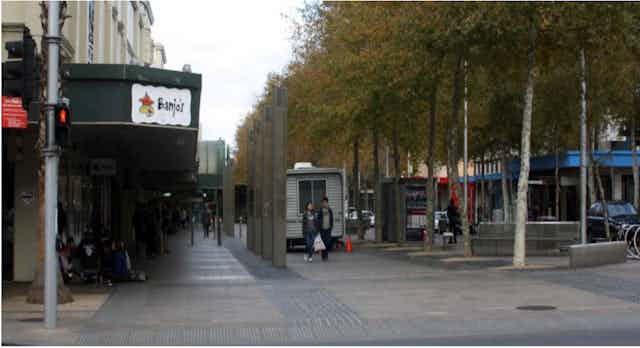This is the sixth article in our Contested Spaces series. These pieces look at the conflicting uses, expectations and norms that people bring to public spaces, the clashes that result and how we can resolve these.
There are few more telling signs of conflict in urban spaces than calls to send in the police. Geelong’s Little Malop Street Mall has been the subject of many such calls, as regular incidents keep the space in the media spotlight.
But Geelong-based writer Ross Mueller’s 2015 call for the police to be called in to investigate “criminal neglect of our public place” comes at the problem from a new angle.
“That’s right,” Mueller began. “We need a whole division to investigate exactly who approved the brilliant idea of building two massive shopping (centres) right next door to each other.” He proposed “the biggest working bee in our history” to rip up the space and start from scratch.
Even if said working bee came to pass, the spatial issues behind the mall’s malaise need to be understood. While an influx of police has often been seen as a way to “fix” the mall, such approaches deal with symptoms rather than the causes of conflicts in such spaces.
The mall’s story has vital lessons for cities around Australia. Chief among them is that public spaces not designed for all can become stages of conflict and alienation. While the centre may hold the focus, the edges of these spaces hold the key.
Haven of the ‘mall rat’
In the 1860s, the area comprising today’s Little Malop Street Mall was part of Market Square, then a large public reserve in the east of the city centre. Its story has been controversial, with privatisation for commercial interests gradually eroding the space over time.
In 1985, what remained of the square and a network of streets was replaced by the Market Square Shopping Centre. This left the narrow rump of public space to the south that is now the mall.
The shopping centre, and another built on the other side of the mall soon after, closed over a connected network of streets similar in form to Melbourne’s celebrated Hoddle Grid. This loss of lively streets and laneways has made this section of Geelong’s city centre less permeable and less pedestrian-friendly.
While the introverted centres have prospered, the mall has become a space as feared and fretted over as the people locally derided as “mall rats” who have become associated with it.
Public perceptions of the space have declined in spite of various interventions, including redevelopments and communications campaigns targeting antisocial behaviour.
Conflicted messages and purposes
The conflict between users of Little Malop Street Mall is rooted in two larger interrelated conflicts. One is between the operation of space as a public common and space for profit. The other stems from the conflicted messages that the space sends to users.
People interpret spaces, and the messages we receive are shaped by several factors. These range from our interaction with physical factors like objects within the space, the space’s edges and how we navigate through spaces, through to discourses or texts that French philosopher Henri Lefebvre identified as “representations of space”.
A successful public space or commons sends messages that make it welcoming to all. The space encourages interaction and invites people to linger.
In this context, defensive interventions aimed at excluding particular groups, such as playing loud classical music to deter so-called “mall rats”, are particularly problematic. Measures that seek to exclude one group often generate a space that deters all.
More successful interventions to activate the mall have involved organised programs of events such as food trucks and live entertainment. But when the carnival moves on, the design problems remain.
Conflict by design
The shopping centre’s opening was clearly a decisive blow in favour of privatised space. Even more significant, though, is the way the centre is designed to turn its back on the public spaces and streets around it.
This speaks to the importance of edges in urban design. While the centre’s boxy form and bulky scale overshadow the mall, the biggest issue is at street level. Here, long stretches of blank concrete walls, loading docks, tagged shopfronts and security grilles form the centre’s face to the mall.


This stark edge sends a message that the space is unsafe and unwelcoming, positioning the mall’s public function as secondary to the profit-driven centre. While in theory the mall is a public space, these hard edges send the clear message that it is not a place for people.
Contrast this with a lively space where the edges between streetfronts and shops are open, with lots to attract eyes and people. Danish architect Jan Gehl, a key figure in the reinvigoration of inner-city Melbourne, writes in his 2010 book Cities for People:
When the city’s edges work, they reinforce city life. Activities can supplement each other, the wealth of experience increases, walking becomes safer and distances seem shorter.
The good news is that hints for creating a better mall are literally metres away. In Little Malop Street, west of the mall, narrow shopfronts on both sides of a one-way street and pedestrianised area form lively edges. These have laid the foundation for a renaissance of city life: dining, activity and a totally new vibe.
The mall’s edges are not the only issue confronting the space, but they are fundamentally important. Other interventions such as streetscape works will be of little use if the inactive edges remain.
You can read other pieces in the series as they are published here.

